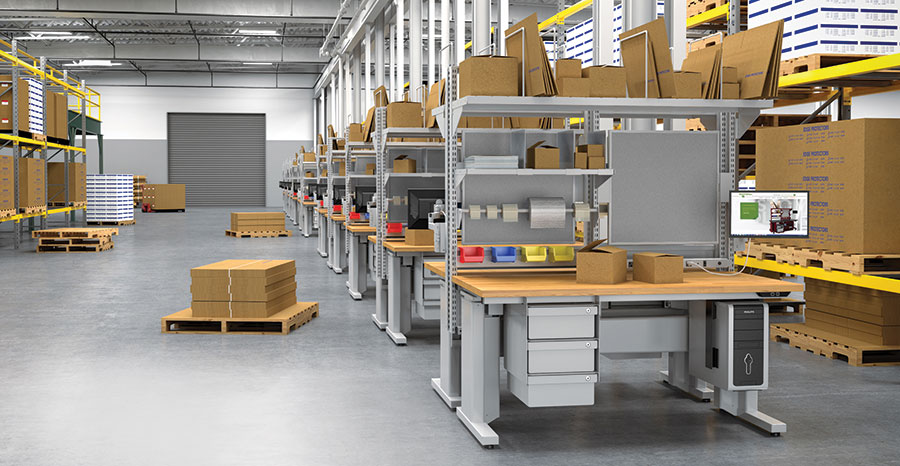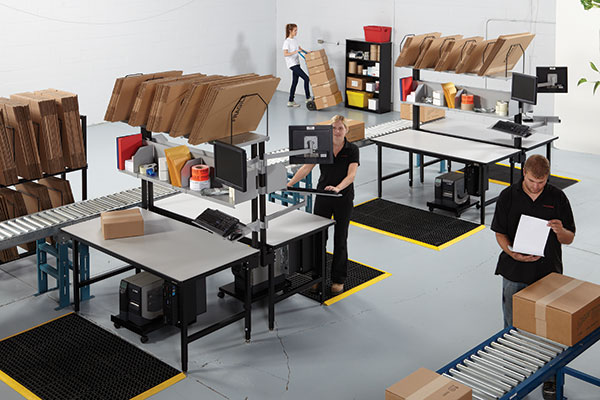The way to perfect packout
The manual pack out station can be an afterthought when it comes to optimal material flow. When equipment is configured to meet the ergonomic needs of operators and blend automation process flow and presentation of goods with efficient process steps at the station, it’s an opportunity to make pack out more productive and safer.
Most any well-built workbench can be at the center of a pack out station, but that doesn’t necessarily mean it will support an optimal pack out process.
To achieve a process that’s fast and efficient, yet also ergonomic, takes more than equipment: it takes thinking about the process steps involved, consideration of the range of packages that need to be handled, as well as physical height and reach differences in the workforce. This process thinking is more important than issues like the gauge thickness of one workbench versus another, say equipment providers.
If you can integrate workflow considerations with the ergonomic needs of the operators, a productive pack out process should follow, says Jeff Dehnert, president of Dehnco, a provider of workbench solutions. Dehnert describes his approach as one of “integration,” in that pack out is often a blend of automated presentation of goods, pack out equipment, people and devices like monitors, printers, scanners and scales.
“When we think about how to improve productivity in pack stations, the No. 1 issue is integration,” says Dehnert. “For example, how well does the manual process at a pack station integrate the automation and how things flow into pack out? How well the pack out station integrates with the flow and process really affects your outcome.”
For example, Dehnert explains, consider how goods arrive at pack out, whether by conveyor, by mobile robots with totes on top, or manually pushed carts or on pallets. Ideally, he adds, the workbench and surface should be at the right height to meld with the presentation mode. “If you’re not integrating the table with how things are flowing, that can be a huge productivity issue,” says Dehnert.
There are many tips on how to select, configure and use equipment in a pack out station. Workbenches are at the center of the action. These come in many sizes, shapes and have different features like height adjustability, storage, dividers and work surfaces. For example, as Dehnert points out, if goods or totes arrive on conveyor, an “over conveyor” workbench might be best.
Providers of industrial workbenches say it can make a productivity and employee health difference in how you configure a pack out area. Top considerations include ingress of goods and workflow, weight and size of typical packages, and ergonomic factors of many kinds, from reach distances to how often different operators use the same table.
Flow meets ergonomics
Keeping operator ergonomics in mind not only helps avoid strain and injury, it contributes to packing speed. Improving ergonomics takes some assessment of how operators need to move.
“From a process engineering perspective, consider how your operators are moving,” says Dehnert. “How are they most frequently turning, or reaching, or grabbing for materials or tools or packages, and how can you make those movements more efficient to save small increments of time?”
By assessing these process and flow considerations, the operation can then make better decisions about equipment, such as where to store materials, tools, and where to mount devices like monitors. “It’s about making sure you understand the process and flow factors—the choices around equipment components are almost secondary,” says Dehnert.
For sound ergonomics, it’s best for the operator to be in a good “neutral” position for most work, says Nina Neuschuetz, marketing manager for BOSTONtec, a provider of workstation solutions. “It all starts with good positioning in terms of the height of the station, not only for one worker, but for multiple workers using the same station. You might have one operator who is 5 foot, 5 inches tall and another who is 6 foot, 5 inches, so easy height adjustability is important.”
For distribution centers with three shift operations and busy pack out stations, it helps to have an electronic height adjustability. Some controls even have memory settings for multiple workers, so that with the push of a button, the height of the work surface can be changed. “When a worker comes in for a shift, he or she can just hit a button, and right away, they’re in a good, neutral position,” says Neuschuetz.

Pack stations set up with ergonomics in mind reduce worker strain and improve productivity by keeping materials close at hand and the work surface at the right height.
For smaller or lower volume operations, workbenches with mechanical height adjustability can work out well, notes Dehnert, but the relatively small added cost of electronic adjustability is well worth it for higher volume or multi-shift operations.
The size and height of the cartons being packed up and sealed also drives the need for easy height adjustability. If for one shift the pack station will be processing larger, taller boxes, it’s probably best to lower the work surface to avoid high-up arm movements, says Bob Simmons, senior vice president with Proline, a provider of workbench solutions. “The higher the box, the lower you want the work surface, while conversely, if you’re working with smaller boxes, you want to raise the table,” says Simmons.
Materials placement
Another key ergonomic is where to store materials like corrugate, bags, tape, labels or devices like a bar code printer that generates shipping labels. For the most frequently used materials, advises Neuschuetz, it’s best to put those into a zone reach of 14 inches or less from the operator, not only for reaches that are horizontal in nature, but also up or down.
“You don’t want to create repetitive motions that involve reaching under the work surface,” Neuschuetz. “Frequent bending isn’t a good thing, and you also don’t want the operator to be reaching over the shoulder. Over-the-shoulder reaching causes strain.”
The prime reach zone, says Neuschuetz, should be reserved for the most frequently used cartons and materials like a tape dispenser or void fill supplies. Infrequently used cartons or tools might be better stored on a nearby cart or shelf, even if it involves walking. “It can actually be good for operator comfort to change positions now and then and take a few steps away from the station, as long as it’s not too frequent,” she says.
Workbench vendors offer many types of shelving and storage options, and typically have adjustable dividers and other features that make it possible to neatly organize materials so the most frequently used items are closest.
Simmons says a handy feature for Proline’s workbenches is a mid-shelf with 4 inches of clearance that hangs right under the center of the work surface. Such areas can be used to hold small tools that are frequently used, or material like tissue paper that might need to be close at hand if packing fragile items. “The goal with many of these workstation features is to organize the area so that most everything the operator needs is within easy reach,” says Simmons.
Some pack out operations will also task the operators with placing collateral like flyers, coupons, brochures or other document into the carton before sealing it up. These, too, need to be in easy reach, along with cartons/bags and void fill. Here is where dividers that can adjust and slide help the operators organize the collateral, so they are easy to insert in an efficient sequence.
Operator-centric
Since manual pack stations are highly dependent on people, it’s important to design everything with operator comfort in mind. Devices and equipment like flat screen monitors, bar code printers, or document printers need to be close and easily adjustable for the operator.
In most cases, mounts for flat screens and printers can pivot easily. “More and more operators are getting the lists and instructions electronically by looking at flat screen monitors, so these need to be easily adjustable to be at the right height and distance to make them easy to read or to reduce glare,” says Simmons.
Lighting in the pack out area is sometimes an overlooked factor. “If the lighting is not good in the facility’s pack out area, that does tend to increase fatigue, so don’t forget to consider lighting improvements,” says Simmons.
Lifting heavy cartons or totes is a major source of strain for operators. For pack stations that have heavier orders that come in on a conveyor, vendors may offer features such as workbench designs that have conveyor running through them, that have roller tops as part of the main surface, or have conveyor alongside the main work surface.
Suppliers may also offer features like scales that are flush with the work surface, or mechanisms like a “ball transfer” surface that allow heavy goods to slide right onto the surface. Some ball transfer surfaces have a pneumatic retractable option, says Neuschuetz, that allows the balls to be lowered to create a normal work surface, and raised again when a carton is ready to be moved again.
The idea is to easily slide and guide heavier items through the pack station, rather than repeatedly lifting cartons. “Lifting is a major ergonomic strain, especially when done frequently,” Neuschuetz says.
Keeping operator comfort at the center of pack station design remains essential, concludes Dehnert, even with more DCs layering in additional automation. As more DCs begin using automation like mobile robots to deliver goods, this could necessitate tweaks to pack out stations, such as workbenches with better height adjustability.
Dehnert says that in the past, he has come across DC redesign projects that go into deep details on how automation systems will work and the resulting material flow, but when it comes to the pack out stations, it’s “just a rectangle” on a drawing. This is an opportunity for pack station equipment providers, he adds, who can help with process improvement or cost effectively come up with customized products.
“We see ourselves as being like an integration point between the automation and the manual processes that need to happen at pack out,” Dehnert says. “It’s all about thinking through the flow and the process you want to create, and keeping worker health at the center of things.”













